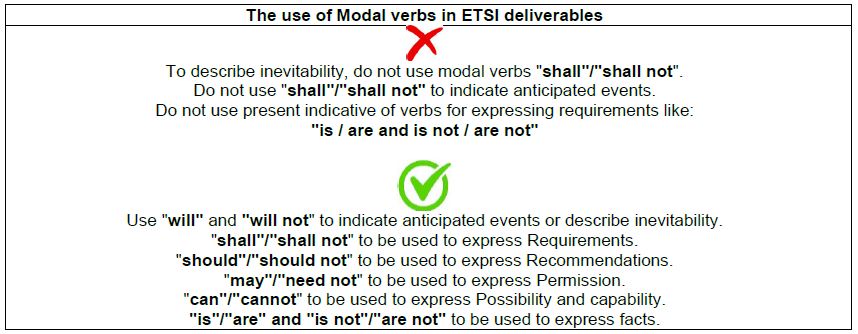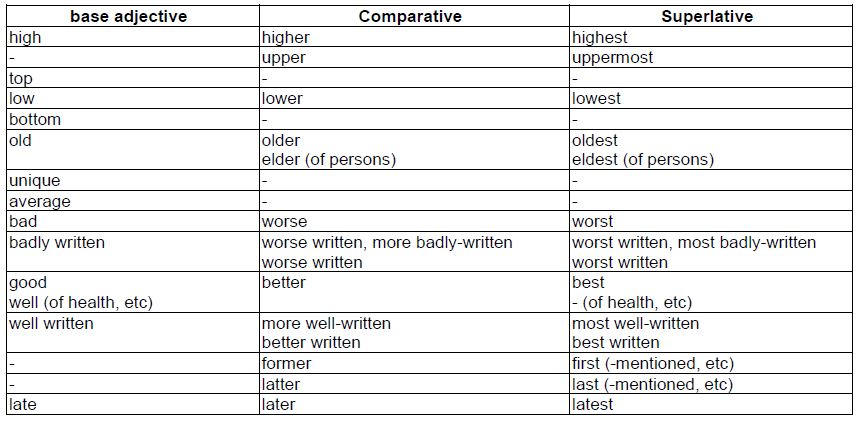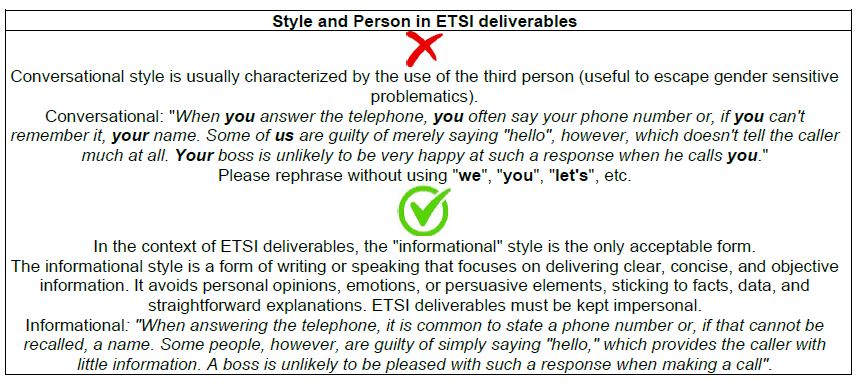Use of English: Difference between revisions
No edit summary |
|||
| Line 135: | Line 135: | ||
It is important to know the use of modal verbs can be tricky even for native British English speakers. | It is important to know the use of modal verbs can be tricky even for native British English speakers. | ||
Therefore to express Requirements, Recommendations, Permission, Possibility and Capability in ETSI deliverables, please refer to [https://portal.etsi.org/Resources/ETSI-Directives clause 3.2 of the ETSI Drafting Rules]. | Therefore to express Requirements, Recommendations, Permission, Possibility and Capability in ETSI deliverables, please refer to [https://portal.etsi.org/Resources/ETSI-Directives clause 3.2 of the ETSI Drafting Rules]. | ||
[[File:Figure19.jpg|center]] | |||
=Adjectives: Comparatives & Superlatives= | |||
The general rule is that the comparative is constructed by adding -'''er''' to the root, and the superlative by adding -'''est'''. | |||
[[File:Figure20.jpg|center]] | |||
The following table illustrates instances where the comparative form of an adjective is formed by adding the word "more" before the base adjective, and the superlative form is created by using "most". | |||
It provides typical examples and also showcases adjectives with irregular comparatives and superlatives. | |||
[[File:Figure21.jpg|center]] | |||
="Style" or "person" to be used in ETSI Deliverables= | |||
The two most common styles of narrative in British English are "conversational" and "informational". | |||
[[File:Figure22.jpg|center]] | |||
=The indefinite article= | |||
The form "a" is used except before a vowel sound, when it changes to "an". | |||
Indeed, contrary to most grammar rules, it is the sound of what follows which decides the case, not the spelling. | |||
[[File:Figure23.jpg|center]] | |||
=Italics= | |||
The ETSI Drafting Rules state: "Use italic for citations, linguistic expressions or when a word/text/expression is extracted from a specific context." | |||
Italic font serves to emphasize citations, linguistic expressions, or text and phrases, including foreign words and scientific names. It's important to note that either italics or quotation marks can be used to cite quotations from references and papers. | |||
However, it's been observed that there's a tendency to overuse italics in ETSI deliverables. | |||
Bold should be used only to emphasize text. | |||
[[File:Figure24.jpg|center]] | |||
=For further reading= | |||
For further reading, please take a look at the following: | |||
[https://www.oed.com/?tl=true The Oxford English Dictionary] | |||
[https://www.collinsdictionary.com/dictionary/english The Collins English Dictionary] | |||
[https://www.iso.org/ISO-house-style.html ISO House Style] | |||
[https://commission.europa.eu/document/download/c45f5b70-2d0e-4da7-b181-b5fe3a16c4bb_en European Commission: English Style Guide] | |||
Revision as of 10:48, 18 September 2024
Scope and Application
The present guide has been prepared by the ETSI Secretariat and is intended for English-language authors, including Chairs, Rapporteurs and STF TTF Experts involved in ETSI deliverables.
Regardless of whether English is your native language, the aim of this guide is to promote clarity and simplicity in written communication. ETSI deliverables have traditionally been drafted in English since the organization's inception in the 1980s. Over time, the English style adopted by ETSI has evolved to become clearer and less influenced by specific cultural nuances. Factors such as ETSI's location in the south of France, the diverse nature of its staff, and its international membership have contributed to this evolution.
In addition to its technical content, ETSI deliverables are characterized by a consistent writing style and a distinct visual identity. Since its establishment, ETSI's documents have been instantly recognizable to its readership. This guide serves as a reference for ETSI authors, aiming to streamline the writing process and maintain consistency across deliverables. The transition of this document into a wiki format aims to simplify its content, retaining only essential information.
British vs. American spelling
Use British rather than American spelling in all cases.
Spelling of -ise / -ize / -yse / -yze
Following a common convention used by several European SDOS, -ize shall be used when the suffix is added to create a verb from a stem which is a noun. This rule, although contrary to many Britons' instinct, is in fact "better" English than -ise. An important exception to the above rule is aligning ETSI spelling rules with European Standardisation Regulation in their spelling of the term Harmonised Standard (spelled with "s" rather than "z").
More importantly, -ise or -ize usage needs to be consistently applied in ETSI deliverables. Please refer to the complete list of ize/ise words used in ETSI standards.
Hyphens in Microsoft Word®
The safest way to not make mistakes is to try and never break words - turn automatic hyphenation off in your word processor, which will tend to hyphenate in American (where the rules are laxer) rather than British English.
To control hyphenation in Microsoft Word, please consult Microsoft Support
Prefixes and when to use hyphens
A prefix is a half word (e.g. anti-, ex-, post-, pre-) placed before a word to modify its meaning. Most prefixed words can be written with or without a hyphen after the prefix.
Avoid using a hyphen with a prefix. However, if you feel the word appears too odd without a hyphen or if your spellchecker flags it as incorrect, you may use a hyphen.
Apostrophes
The apostrophe is used to indicate, amongst other things, the possessive case in English. A singular noun is made possessive by the addition of 's.
Contractions
A contraction is formed by combining two words and omitting one or more letters. As mentioned above, contractions like "isn't" (is not), "can't" (cannot), "won't" (will not), "it'll" (it will), "it's" (it is), etc. though common in speech, are not allowed in ETSI deliverables. The markers of abbreviations are either apostrophes or full stops.
Abbreviations
An abbreviation is formed using the initial letters (or sometimes other parts) of a longer word or phrase to represent the whole.
Plurals
When forming the plural of abbreviations, treat them as regular nouns by simply adding an 's', even if the plural noun does not come at the end of the abbreviated phrase.
Some words have irregular plurals. Some compound nouns are also troublesome. Some likely to cause confusion are the following words:
See below a list of words which have no plural form.
Use of gender-sensitive terminology
For further details please consult the gender sensitive terminology guide.
Please be aware that editHelp! encourages the usage rules determined in this guide but does not practise sensitivity reading when reviewing ETSI standards.
Upper case and lower case
Proper nouns are always capitalized. Otherwise, nouns are given in lower case, i.e. words such as committee, organization, secretariat, report, government only have a capital when part of a full title, e.g. the ETSI Secretariat.
It is to be noted that words such as clause, annex, table, figure are to be used either capitalized or not. What is important in these cases is the consistency throughout the whole document.
Symbols
Scientific units
The use of scientific units can be tricky though ETSI is aligned with current international practices. See below the table for further information.
Further examples in the table below.
Foreign words and phrases
Many words of foreign origin are in common usage, and it can be tempting to use them in ETSI deliverables. However, these words are to be used with caution and if a British English equivalent exists it is preferable to opt for the most common or widely known option.
Only the most commonly used foreign words are allowed and all others risk being flagged by editHelp!. It is also unnecessary to italicize foreign words.
Numbers
ETSI uses the same convention adopted by all major SDOs in Europe where the decimal point is represented by a comma, and that the separator between groups of three digits is a space (except four-digit numbers representing years have no separator as well as for pixels).
Infinitive of verbs
There is often confusion whether to say, for example, "we propose to draft a standard" or "we propose drafting a standard". The choice is often, as in this case, a matter of personal preference and both are correct. However, there are instances where using the infinitive form is incorrect.
See example in table below.
Negatives
The basic rule is only one negation allowed in a British English sentence, and any required degree (of negativity) must be added by the use of adverbs.
Verbal forms for the expressions of provisions
It is important to know the use of modal verbs can be tricky even for native British English speakers. Therefore to express Requirements, Recommendations, Permission, Possibility and Capability in ETSI deliverables, please refer to clause 3.2 of the ETSI Drafting Rules.
Adjectives: Comparatives & Superlatives
The general rule is that the comparative is constructed by adding -er to the root, and the superlative by adding -est.
The following table illustrates instances where the comparative form of an adjective is formed by adding the word "more" before the base adjective, and the superlative form is created by using "most". It provides typical examples and also showcases adjectives with irregular comparatives and superlatives.
"Style" or "person" to be used in ETSI Deliverables
The two most common styles of narrative in British English are "conversational" and "informational".
The indefinite article
The form "a" is used except before a vowel sound, when it changes to "an". Indeed, contrary to most grammar rules, it is the sound of what follows which decides the case, not the spelling.
Italics
The ETSI Drafting Rules state: "Use italic for citations, linguistic expressions or when a word/text/expression is extracted from a specific context."
Italic font serves to emphasize citations, linguistic expressions, or text and phrases, including foreign words and scientific names. It's important to note that either italics or quotation marks can be used to cite quotations from references and papers.
However, it's been observed that there's a tendency to overuse italics in ETSI deliverables. Bold should be used only to emphasize text.
For further reading
For further reading, please take a look at the following:























